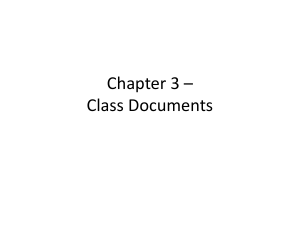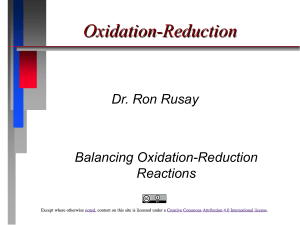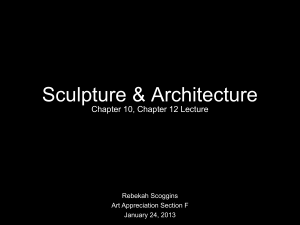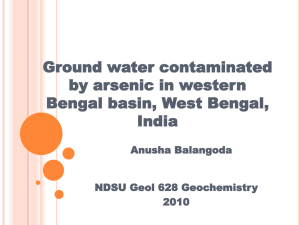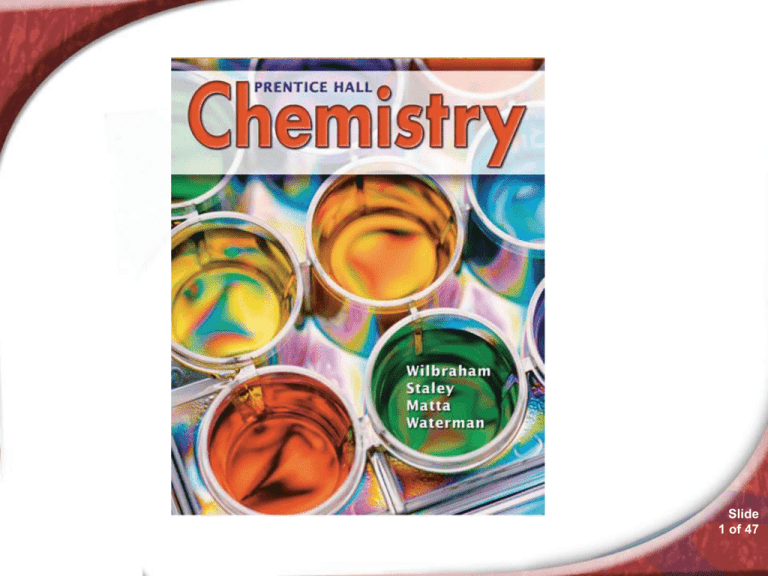
chemistry
Slide
1 of 47
20.3
Balancing Redox Equations
When concentrated hydrochloric
acid (HCl) and nitric acid (HNO3)
are mixed with gold, oxidation
and reduction reactions produce
gaseous nitrogen monoxide (NO)
and soluble, stable AuCl4– ions.
You will learn how to write and
balance chemical equations for
redox reactions such as this one.
Slide
2 of 47
© Copyright Pearson Prentice Hall
20.3
Balancing Redox Equations
> Identifying Redox Reactions
Identifying Redox Reactions
How are oxidation numbers used to
identify redox reactions?
Slide
3 of 47
© Copyright Pearson Prentice Hall
20.3
Balancing Redox Equations
> Identifying Redox Reactions
If the oxidation number of an element in
a reacting species changes, then that
element has undergone either oxidation
or reduction. Therefore, the reaction as a
whole must be a redox reaction.
Slide
4 of 47
© Copyright Pearson Prentice Hall
20.3
Balancing Redox Equations
K + H2O KOH + H2
> Identifying Redox Reactions
2Zn + HCl ZnCl2 + H2
Slide
5 of 47
© Copyright Pearson Prentice Hall
20.3
Balancing Redox Equations
> Identifying Redox Reactions
A redox reaction takes place between nitrogen
and oxygen when lightning bolts heat the air.
Slide
6 of 47
© Copyright Pearson Prentice Hall
20.3
Balancing Redox Equations
> Identifying Redox Reactions
A color change can signal a redox reaction.
Slide
7 of 47
© Copyright Pearson Prentice Hall
Slide
8 of 47
© Copyright Pearson Prentice Hall
Slide
9 of 47
© Copyright Pearson Prentice Hall
Slide
10 of 47
© Copyright Pearson Prentice Hall
Practice Problems for Conceptual Problem 20.4
Problem Solving 20.18 Solve
Problem 18 with the help of an
interactive guided tutorial.
Slide
11 of 47
© Copyright Pearson Prentice Hall
20.3
Balancing Redox Equations
> Two Ways to Balance Redox
Equations
Two Ways to Balance Redox Equations
How are changes in oxidation numbers
used to balance a redox equation?
What is the procedure for balancing a
redox equation using half-reactions?
Slide
12 of 47
© Copyright Pearson Prentice Hall
20.3
Balancing Redox Equations
> Two Ways to Balance Redox
Equations
Using Oxidation-Number Changes
In the oxidation-number-change method, you
balance a redox equation by comparing the
increases and decreases in oxidation numbers.
Slide
13 of 47
© Copyright Pearson Prentice Hall
20.3
Balancing Redox Equations
> Two Ways to Balance Redox
Equations
To use the oxidation-number-change method,
start with the skeleton equation for the redox
reaction.
Slide
14 of 47
© Copyright Pearson Prentice Hall
20.3
Balancing Redox Equations
> Two Ways to Balance Redox
Equations
Step 1 Assign oxidation numbers to all the
atoms in the equation.
Slide
15 of 47
© Copyright Pearson Prentice Hall
20.3
Balancing Redox Equations
> Two Ways to Balance Redox
Equations
Step 2 Identify which atoms are oxidized and
which are reduced.
Step 3 Use one bracketing line to connect the
atoms that undergo oxidation and another such
line to connect those that undergo reduction.
Slide
16 of 47
© Copyright Pearson Prentice Hall
20.3
Balancing Redox Equations
> Two Ways to Balance Redox
Equations
In a balanced redox equation, the total
increase in oxidation number of the
species oxidized must be balanced by
the total decrease in the oxidation
number of the species reduced.
Slide
17 of 47
© Copyright Pearson Prentice Hall
20.3
Balancing Redox Equations
> Two Ways to Balance Redox
Equations
Step 4 Make the total increase in oxidation
number equal to the total decrease in oxidation
number by using appropriate coefficients.
Slide
18 of 47
© Copyright Pearson Prentice Hall
20.3
Balancing Redox Equations
> Two Ways to Balance Redox
Equations
Step 5 Finally, make sure that the equation is
balanced for both atoms and charge.
Slide
19 of 47
© Copyright Pearson Prentice Hall
Slide
20 of 47
© Copyright Pearson Prentice Hall
Slide
21 of 47
© Copyright Pearson Prentice Hall
Slide
22 of 47
© Copyright Pearson Prentice Hall
Slide
23 of 47
© Copyright Pearson Prentice Hall
Practice Problems for Conceptual Problem 20.5
Problem Solving 20.20 Solve
Problem 20 with the help of an
interactive guided tutorial.
Slide
24 of 47
© Copyright Pearson Prentice Hall
20.3
Balancing Redox Equations
> Two Ways to Balance Redox
Equations
Using Half-Reactions
• A half-reaction is an equation showing just
the oxidation or just the reduction that takes
place in a redox reaction.
• In the half-reaction method, you write and
balance the oxidation and reduction halfreactions separately before combining them
into a balanced redox equation.
Slide
25 of 47
© Copyright Pearson Prentice Hall
20.3
Balancing Redox Equations
> Two Ways to Balance Redox
Equations
To balance a redox reaction using halfreactions, write separate half-reactions
for the oxidation and the reduction. After
you balance atoms in each half-reaction,
balance electrons gained in the
reduction with electrons lost in the
oxidation.
Slide
26 of 47
© Copyright Pearson Prentice Hall
20.3
Balancing Redox Equations
> Two Ways to Balance Redox
Equations
Slide
27 of 47
© Copyright Pearson Prentice Hall
20.3
Balancing Redox Equations
> Two Ways to Balance Redox
Equations
Slide
28 of 47
© Copyright Pearson Prentice Hall
20.3
Balancing Redox Equations
> Two Ways to Balance Redox
Equations
The oxidation of sulfur by nitric acid in aqueous
solution is one example of a redox reaction that
can be balanced by the half-reaction method.
Slide
29 of 47
© Copyright Pearson Prentice Hall
20.3
Balancing Redox Equations
> Two Ways to Balance Redox
Equations
Steps 1 and 2
Slide
30 of 47
© Copyright Pearson Prentice Hall
20.3
Balancing Redox Equations
> Two Ways to Balance Redox
Equations
Step 3a
Slide
31 of 47
© Copyright Pearson Prentice Hall
20.3
Balancing Redox Equations
> Two Ways to Balance Redox
Equations
Step 3b
Slide
32 of 47
© Copyright Pearson Prentice Hall
20.3
Balancing Redox Equations
> Two Ways to Balance Redox
Equations
Steps 4 and 5
Slide
33 of 47
© Copyright Pearson Prentice Hall
20.3
Balancing Redox Equations
> Two Ways to Balance Redox
Equations
Steps 6 and 7
Slide
34 of 47
© Copyright Pearson Prentice Hall
Slide
35 of 47
© Copyright Pearson Prentice Hall
Slide
36 of 47
© Copyright Pearson Prentice Hall
Slide
37 of 47
© Copyright Pearson Prentice Hall
Slide
38 of 47
© Copyright Pearson Prentice Hall
Slide
39 of 47
© Copyright Pearson Prentice Hall
Slide
40 of 47
© Copyright Pearson Prentice Hall
Practice Problems for Conceptual Problem 20.6
Problem Solving 20.21 Solve
Problem 21 with the help of an
interactive guided tutorial.
Slide
41 of 47
© Copyright Pearson Prentice Hall
20.3
Balancing Redox Equations
> Choosing a Balancing Method
Choosing a Balancing Method
• Balancing by oxidation number change
usually works well if the oxidized and reduced
species appear only once on each side of the
equation.
• Balancing by the half-reaction method works
best in redox reactions where the same
element is both oxidized and reduced and in
reactions that take place in acidic or alkaline
solution.
Slide
42 of 47
© Copyright Pearson Prentice Hall
20.3 Section Quiz.
Assess students’ understanding
of the concepts in Section 20.3.
Continue to:
-or-
Launch:
Section Quiz
Slide
43 of 47
© Copyright Pearson Prentice Hall
20.3 Section Quiz
1. Choose the correct words for the spaces. One
method used to balance redox reactions
compares changes in ______ numbers.
When an equation is balanced, the total
number of _________ lost must be equal to
the total number gained.
a. oxidation, electrons
b. oxidation, protons
c. atomic, electrons
d. mass, protons
Slide
44 of 47
© Copyright Pearson Prentice Hall
20.3 Section Quiz
2. Choose the correct numbers for the spaces. Balance
the equation below with whole-number coefficients
using the oxidation-number-change method.
NH3 + O2 NO2 + H2O
The least common multiple of the changes in
oxidation numbers of atoms is _____, and the
coefficient of water in the balanced equation is _____.
a. 14, 6
b. 14, 3
c. 28, 3
d. 7, 6
Slide
45 of 47
© Copyright Pearson Prentice Hall
20.3 Section Quiz
3. Balance the equation below with the lowest wholenumber coefficients using the half-reaction method.
Ag+(aq) + SO2(g) + H2O(l) Ag(s) + SO42–(g) + H+(aq)
The reduction half-reaction must be multiplied by
a. 1
b. 2
c. 3
d. 4
Slide
46 of 47
© Copyright Pearson Prentice Hall
Balancing Redox Equations
> Concept Map 20
Concept Map 20 Create
your concept map using
the computer.
Slide
47 of 47
© Copyright Pearson Prentice Hall
END OF SHOW

